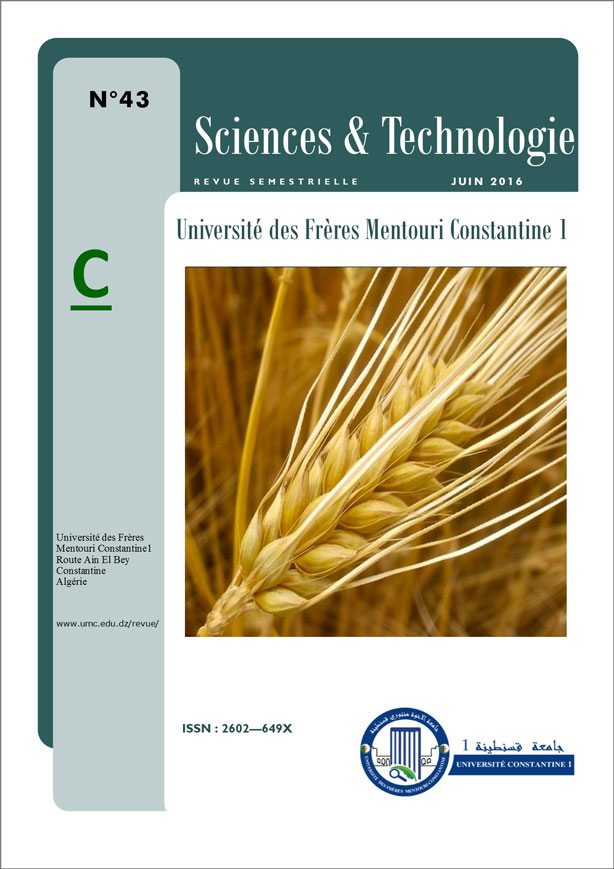EFFECTIVENESS OF THE FLAVONOIDS ISOLATED FROM Thymus inodorus BY DIFFERENT SOLVENTS AGAINST SOME PATHOGENIS MICROORGANISMS
Mots-clés :
Thymus inodorus, Antimicrobial activity, Extraction, flavonoids, strains, solventsRésumé
The aim was to investigate the antimicrobial activity of flavonoids isolated from the aerial part of a medicinal plant which is Thymus inodorus belonging to the Lamiaceae family by the middle agar diffusion method on following microorganisms. We have Staphylococcus aureus, Escherichia coli, Pseudomonas fluorescens, AspergillusNiger, Aspergillus fumigatus and Candida albicans. During this study, flavonoids extracted by stripping with steam are performed. The yields of flavonoids is 7.242% for the aqueous extract and 28.86% for butanol extract, 29.875% for the extract of ethyl acetate and 22.9% for the extract of di - ethyl. The evaluation of the antibacterial effect shows that the diameter of the zone of inhibition varies from one microorganism to another. The operation values obtained show that the bacterial strain P fluorescens, and three yeasts and molds; A. Niger, A. fumigatus and C. albicans are the most resistant. But it is noted that, S. aureus is shown more sensitive to crude extracts, the stock solution and the various dilutions. Finally for the minimum inhibitory concentration is estimated only with the crude extract of Thymus inodorus flavonoid. Indeed, these extracts inhibit the growth of Gram + bacteria at a concentration varying between 0.5% and 1%. While for bacteria to Gram-, it is limited to a concentration of 0.5%.Références
- ISERIN P. "Encyclopédie des plantes médicinales",. Larousse (ed.), France, (2009), p. 355.
- BERUBE-GAGNON J. "Isolation et identification de composés antibiotiques des écorces de Picea mariana",. Mémoire de l’Université de Québec, (2006), 205 p. 205.
- NAGHIBI F., MOSADDEGH M., MOTAMED S.M., GHORBANI A. Labiatae family in folk medicine in Iran: from ethnobotany to pharmacology. Iranian Journal of Pharmaceutical Research. Vol. 2. (2005). pp. 63-79.
- BEHIDJ-BENYOUNES N., DAHMENE T., BEHIDJ K. K., GANA S., et CHEBOUTI N. Evaluation de l’effet antimicrobien de l’huile essentielle de Thymus numidicus à Chréa. Le VIIème Séminaire International de Médecine Vétérinaire. Sous le thème: Santé Animale et Sécurité Alimentaire, Constantine, 11-12 Avril 2015.
- MARTA C. "Activité antimicrobienne de plantes médicinales et aromatiques utilisées au Universida de Estadual de Campinas",. Brésil, (2006), p. 16.
- MARKHAM K. "Techniques of flavonoid identification",. Biological Techniques Series: Series editors: J.E. Treheme and P.H. Rubery, Academic Press France, (1982), p p. 36-93.
- BRUNETON J. "Phytochimie. Plantes medicinales",. Tec-Doc (ed.), París, (1999), p. 315 p.
- SACCHETTI G., MAIETTI S., MUZZOLI M., SCAGLIANTI M., MANFREDINI S., RADICE M., and BRUNI R. Comparative evaluation of 11 essential oils of different origin as functional antioxidants, antiradicals and antimicrobials in foods. Food Chemistry. Vol. 91. (2005). pp. 621-632.
- CELIKTAS O.Y., HAMES KOCABAS E., BEDIR E., VARDAR SUKAN F., OZEK T., and BASER K. H. C. Antimicrobial activities of methanol extracts and essential oils of Rosmarinus officinalis, depending on location and seasonal variations. Food Chemistry. Vol. 100. (2007). pp. 553-559.
- FAUCHERE J L et AVRIL J L. " Bactériologie générale et médicale",. Ellipses (ed.), France, Paris,
(2002), p. 365.
- HULIN A, DEGUILLAUME A. M., BRETAGNE S, et BEZIR Y. Bon usage des antifongiques dans le traitement des candidoses et aspergillose invasives. Journal of Pharmeutical Medecine. Vol. 24. (1998). pp. 125-38.
- MARINO M., BERSANI C. and COMI G. Impedance measurements to study the antimicrobial activity of essential oils from Lamiaceae and Compositae. International Journal of Food Microbiology. Vol. 67. (2001). pp. 187-195. [13]- POLLIEN P., OTT A., MONTIGNON F., BAUMGARTNER M., MUÑOZ-BOX R. and ALAIN C. Hyphenated headspace-gas chromatography-sniffing technique: screening of impact odorants and quantitative aromagram comparisons. Journal of Agricultural Food Chemistry. Vol. 45 (7), (1997). pp. 2630–2637.
- MANN C.M., COSS S. D. and MAEKHAM J. L. The outer membrane of Pseudomonas aeruginosa NCTC 6749 contributrs to its tolerance to the essential oil of Melaleuca alternifolia (Tea tree oil). Letters in Applied Microbiology. Vol. 30. (2000). pp. 294 - 297.
- FZUCHERE J. 2002 - Bactériologie générale et médicale. Éd. Ellipses, Paris, 365 p.
- SENATORE F, NAPOLITANO F., and OZCAN M. Composition and antibacterial activity of essential oil from Crithmum maritimum L. (Apiaceae) growing wild in Turkey. Flavour and Frangrance Journal, Vol. 15. (2000). pp. 186 - 189.
- PINGOT A. "Les huiles essentielles",. (ed.), Tec. et Doc, Paris, France, (1998), pp. 230-236.
- BROOKS J.D., and CORKE H. The in vitro antibacterial activity of dietary spice and medicinal herb extracts. International Journal of Food Microbiology. Vol. 117. (2007). pp.112- 119.
- NAKATSU T, LUPO A, CHINN J R., KANG R. Biological activity of essential oils and their constituents. Studies in Natural Products Chemistry. Vol. 21. (2000). pp.571-631.
- MEBAREKI N., " Extraction de l’huile essentielle de Thymus fontanesii application à la formulation d’une forme médicamenteuse-antimicrobienne". Thèse Magister. Faculté des hydrocarbures et de la chimie. Université. M’hamed Bougara Boumerdès, (2010), p 185.
- CHATENET C., Actualités pharmaceutiques. Vol. 473. (2008). pp. 10-23.
